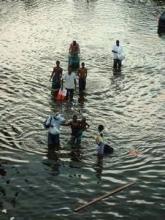NAPA, CALIF. – Although the risk of a serious disease outbreak after natural disasters is rare and often exaggerated by the media, it is important to be prepared to respond to patient infections after such an event, according to Dr. Miriam S. Bettencourt of the University of Nevada in Las Vegas.
Some of the conditions patients may present with after natural disasters include bacterial and fungal infections, leptospirosis, measles, dengue fever, trench foot, arthropod bites, and radiation exposure. Dr. Bettencourt described some of the conditions in detail during her presentation at the Coastal Dermatology Symposisum.
Vibrio
After Hurricane Katrina in 2005, there were 18 reported cases of Vibrio-associated illness because of exposure of patients’ wounds to coastal flood waters. The warm seawater of the Atlantic Ocean that flooded the Gulf Coast was the perfect breeding ground for V. vulnificus and V. parahaemolyticus.
Following the rapid onset of illness, V. vulnificus was identified in 82% of the reported cases, and V. parahaemolyticus in the other 18%, said Dr. Bettencourt. The patients were aged 31-89, with the majority being male (83%); five of the patients died. Comorbidities that may have made people more susceptible to infection, such as heart disease and diabetes, were identified in 72% of the patients.
Vibrio infection starts as edema, erythema, and pain, and, if left untreated, can progress to hemorrhagic blisters, necrotizing fasciitis, and sepsis.
If patients must work in conditions such as those present after Hurricane Katrina, they should wear protective clothing to prevent wound exposure to contaminated water. They should also wash all wounds with soap and water after water exposure to reduce the risk of infection.
"Clinicians should be vigilant for Vibrio infection in hurricane evacuee populations, particularly in patients with infected wounds and especially if the patients are in a high-risk group. If V. vulnificus is suspected, antimicrobial therapy should be initiated immediately; prompt treatment can improve survival," noted the Centers for Disease Control and Prevention (MMWR 2005;54;928-31).
Recommended treatments include doxycycline, third-generation cephalosporins (such as intravenous ceftazidime), fluoroquinolones (such as levofloxacin or cyclosporine), and aminoglycosides. Limb amputation is sometimes necessary, according to Dr. Bettencourt.
MRSA
Wounds are at a particular risk of becoming infected with methicillin-resistant Staphylococcus aureus (MRSA) because of conditions that are likely to occur after a natural disaster, such as close skin-to-skin contact with other individuals, use of contaminated items to treat wounds, a lack of cleanliness, and crowded living conditions.
Dr. Bettencourt recommended looking for signs of MRSA in cuts and abrasions and in areas of a patient that are covered by hair, which could easily be missed.
She noted that new Infectious Diseases Society of America treatment guidelines recommend incision and drainage of mature MRSA infections. Antibiotic treatment should be started if the patient is very young, very old, or immunocompromised; if there are signs of severe or extensive disease; if there is a rapid progression to cellulitis; if symptoms of systemic disease are present; if areas for treatment are difficult to drain (face, hands, genitalia); or if patients are unresponsive to drainage.
Recommended antibiotics include clindamycin, trimethoprim/sulfamethoxazole, tetracycline, doxycycline, minocycline, and linezolid. She pointed out that the presence of pus suggests S. aureus infection, while cellulitis without puss suggests group A streptococcus.
For patients with recurrent MRSA, consider nasal decolonization with mupirocin twice a day for 5 days or body decolonization with bleach baths or chlorhexidine. Oral antibiotics can be started if the patient has active lesions, Dr. Bettencourt said. Family members and close contacts of the patient may need to be evaluated and treated, as well.
Leptospirosis
The floods and mud slides that devastated Rio de Janeiro in January were described as the worst weather-related natural disaster ever to hit Brazil, Dr. Bettencourt said.
Animals carrying the bacterial pathogen Leptospira urinated in the flood waters, which humans then drank or subjected their wounds to.
The bacteria causing leptospirosis can survive for several months, she noted, and the incubation period is 2-4 weeks. Symptoms in people include fever, headache, muscle ache, vomiting, jaundice, red eyes, abdominal pain, diarrhea, and rash (common on the legs). If left untreated, the infection can cause kidney and liver failure.
Severe infection requires hospitalization, and about 5% of patients die (Cochrane Database Syst. Rev. 2000;CD001306). High doses of antibiotics are used to treat patients.
The Centers for Disease Control and Prevention has estimated that there are 100-200 cases of leptospirosis each year in the United States, transmitted primarily through rats and dogs. The infection is most likely to occur in men (75%) – in Hawaii (50%), the Southern Atlantic, and in the Gulf and Pacific coastal states – in July through October.

